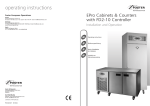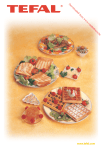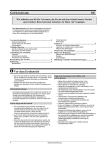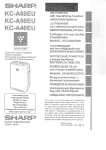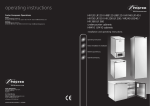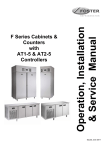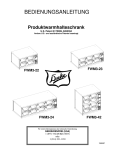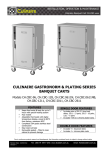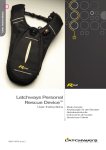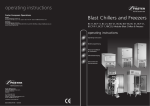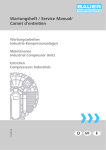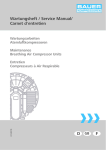Download FOS PROCAB/COU PRINT 30/3/05
Transcript
operating instructions gastro pro range Foster European Operations France Foster Refrigerator France SA Tel: (33) 01 34 30 22 22 Fax: (33) 01 30 37 68 74 Email: [email protected] cabinet & counter installation and operating instructions Germany Foster Refrigerator Germany Tel: (0781) 96 93 00 Fax: (0781) 96 93 019 Email: [email protected] Foster Refrigerator Oldmedow Road, King’s Lynn, Norfolk, PE30 4JU England Tel: 01553 691122 Fax: 01553 691447 Website: www.fosterrefrigerator.co.uk Email: [email protected] a Division of ITW (UK) Ltd. PROCAB0305 GB Operating instructions D Bedienungsanleitung F Notice d'installation et d'utilisation GB english F installation français IMPORTANT: To the installer: Installation of these units should be carried out by a competent person and the appropriate codes of practice adhered to, thus ensuring safe installation. Pass to the user: Do not discard this document: it contains important guidelines on Operation, Loading, Cleaning and Maintenance and should be kept for reference. DISPOSAL REQUIREMENTS If not disposed of properly all refrigerators have components that can be harmful to the environment. All old refrigerators must be disposed of by appropriately registered and licensed waste contractors, and in accordance with National laws and regulations. Positioning/unpacking 1 Cabinet Counter castors legs 2 Castors/legs/feet Please refer to label on back and base of unit for correct fitting of castors Fitting Shelves 4 Cabinet All models are normally fitted with swivel castors. Ensure during installation the unit is level if not the door(s) may not close correctly. Adjust castors by inserting spacers under the appropriate castor and the base of the unit until level. As an alternative adjustable legs can be fitted to all models. As an alternative 8mm threaded adjustable levelling feet are available for ‘U’ mount cabinet models, for all other models 12mm threaded adjustable levelling feet are available . (Fitting method as castors or legs). 3 Shelf/Tray Supports To adjust the position of the trayslides insert the ends into the vertical support with the ‘hooks’ pointing downwards and ‘slot downwards’ into position. Ensure the trayslides are parallel and level after fitting. Shelves must be inserted into the unit so that they sit at the back of the unit. 5 Vaporiser Tray This is only fitted to the Pro 300/300 cabinet models. Slide the vaporiser tray onto its runners on the underside of the cabinet and insert the electrical plug into the socket provided. If the runners are tight loosen slightly and re-tighten after inserting the tray. Ensure tray covers drain outlet. Counter Marine Units 6 Important (Cabinets only): Ensure a minimum clearance of 150mm above unit and ventilation for efficient operation. Where possible, ensure the unit is not adjacent to a heat source. Unpacking: The unit is delivered on a pallet and shrink-wrapped. Documentation is inserted into a clear pocket located inside the unit. Carefully remove the protective plastic film and cardboard from the unit exterior and from the door opening surround making sure that any sharp instrument used does not cause damage, plus remove any quality labels. Cabinet removal from the pallet: Remove the shelf holding the package containing the castors or legs. Remove the retaining bolts which secures the unit to the pallet. Move the unit over the front of the pallet and fit the lockable castors or legs in the mounting holes. To fit the rear castors or legs, lock the front castors, tilt the unit forwards, remove the pallet and fit the castors or legs in the mounting holes. Ensure that all are tightened firmly into position. On double door top mount cabinets, ensure 3 castors are fitted at the front. N.B. Gastro Pro 250/250, 300/300 and all Fish cabinets and counters only. Take care not to damage the drain outlet under the base. All cabinets & counters are heavy and care should be taken when handling. Counter removal from the pallet: Counters fitted with castors - Remove fittings from inside the unit and ensure all drawers and doors are locked before removal from the pallet. Cut the heavy duty cable ties that hold the front castors to the pallet. Unlock the castors and then carefully roll the unit forward off the pallet. Counters fitted with legs - Remove fittings from inside the unit and ensure all drawers and doors are locked before removal from the pallet. Remove the fixing blocks located in front of the legs at the front of the unit and cut the straps securing the unit to the pallet. Carefully manoeuvre the unit forward, off the pallet. Units for marine applications are provided with special marine legs and bulkhead fixings. These units must be installed by specialist marine installation companies. Counter Bulkhead Fixings Cabinet Bulkhead Fixings 2 Marine Leg 19 F français english GB start up 7 Supports standard Démontage crémaillère Démontage des tiroirs 17 Variante armoire á poissons Switching On user operation guidelines Variante armoire de maintien en température Tiroir neutre (option) Ce tiroir est retenu sur ses glissières par des clips plastiques (A). Ces clips doivent être enfoncés pour libérer le tiroir. Foster Standard Controller (FSC) Tiroirs réfrigérés (option) Pour enlever ces tiroirs, les ouvrir à fond et lever pour que les roulements (B) des glissières passent dans les encoches prévues à cet effet. Stand-by / On Button Button 1 Mute / Increase Button Button 4 Initial Start Up Chargement Circulation de l'air Une fois l'armoire chargée, contrôler que l'air peut circuler librement autour des produits stockés. 19 Répartition de la charge La charge de 40 kg 40Kg 20 Aliments maximum par clayettes dolt être uniformément répartie avec un maximum de 160kg par section de 600 litres pour les armoires et de 80 kg par porte pour les meubles bas. Ne pas stocker de produits directement sur le fond des appareils. Couvrir les aliments en séparant les produits crus des produits cuits. Dans les armoires de maintien en température, couvrir les bacs pour éviter tout dessèchement et remplir le bac humidificateur en partie basse avec de l'eau. Défauts 21 Diagnostic 18 Button 2 Temperature Button Button 3 Defrost / Decrease Button by 8 18 If the unit has been laid on its back at any time DO NOT switch on immediately but leave in the upright position for at least 60 minutes. (Not applicable to heated cabinets). To switch on the unit see ‘User Operation Guidelines’. Allow the unit to reach its normal operating temperature before loading with product. 9 Your new Foster Cabinet / Counter will be delivered ready to run. Plug into the mains supply and the unit will operate in the following way. Start Up & Self Test: These indications are only displayed during the first three seconds following mains electrical power being applied to the unit. During this period the controller performs a self-check. (Refer to point 6 - Set Unit to Standby). followed by --- Operator Instructions 1. To Start the Unit Press button 1. Controller will start and air temperature will be displayed. -20 2. To Check Storage Temperature Setting Press button 2. Display temporarily shows current Temperature Set Point. 3. To Increase Storage Temperature (if required) a. Press and hold button 2. b. Press button 4 until required temperature is displayed. c. Release both buttons. 4. To Lower Storage Temperature (if required) a. Press and hold button 2. b. Press button 3 until required temperature is displayed. c. Release both buttons. 5. To Initiate a Manual Defrost (Not applicable to Heated Cabinets) a. Press and hold button 3. b. Press button 1. A timed/temperature defrost will then follow. c. Release both buttons. Defrost Indication This indication is displayed during the defrost cycle. On completion the display will revert back to showing the internal air temperature. 6. Set Unit to Standby Press button 1. display shows: Standby Indication This indication is displayed while the unit is not operating but with mains power still applied to the unit. This mode may be used for internal cleaning regimes and short periods when the unit is not required. For extended periods of inactivity the mains supply should be isolated. 888 --- Les vérifications doivent être effectuées par du personnel autorisé. Avant d'appeler votre revendeur agréé, prière de contrôler les points suivants: Défaut d'alimentation électrique (disjoncteur) Défaut affiché sur le régulateur (voir chapitre alarmes et avertissements) Prise de courant endommagée En cas de besoin d'assistance technique préciser: Le numéro de série de l'appareil Le type de l'appareil. Ces informations se trouvent sur une plaque à l'intérieur de l'armoire. Lorsqu'un code de défaut s'affiche sur le régulateur, mentionner ces indications lors de votre appel téléphonique. 3 GB english F français Nettoyage et entretien Nota: Eteindre l'appareil avant le nettoyage intérieur 13 Alarms and Warnings 10 Instructions de nettoyage Important En en prenant soin, le revêtement inox à la propriété de résister à la corrosion pendant de longues années. Pour conserver ces propriétés, nous recommandons le nettoyage hebdomadaire suivant: a - Extérieur: utiliser un produit spécifique au nettoyage de l'inox (selon instruction du fabricant) b - Intérieur: laver à l'eau savonneuse, rincer et sécher avec un chiffon doux. AVERTISSEMENT Les agents détergents à base de solution alcaline, d'eau de javel, de chlore ou d'acide sont formellement interdites pour le nettoyage des inox. Des traces de corrosion ou de piquage peuvent résulter de leur application délibérée ou involontaire. Au cas où l'un de ces produits entrerait en contact avec une meuble réfrigérée pendant un nettoyage général de la cuisine, rincer immédiatement les parties attaquées avec de l'eau propre et sécher en frottant. Ne jamais utiliser de tampon ou de poudre abrasive sur les surface en inox ou en aluminium. Après le nettoyage, attendre que l'appareil et atteint sa température de fonctionnement avant de le recharger avec les aliments. En cas de salissures pendant l'utilisation, essuyer immédiatement en prenant soin de ne pas mettre la peau en contact avec les parois internes des meubles à température négative ou de maintien en température (risque de brûlures dans les 2 cas). Door Open Alarm. The display will alternately show and the internal air temperature. The controller alarm sounds, but can be stopped by pressing button 4. The display will continue to show the alarm message until cancelled by shutting the door. If the alarm cannot be cancelled by doing this call your Foster Authorised Service Company. 000 High Temperature Alarm. Display shows internal air temperature and 000 alternately. The alarm will sound, but can be switched off for one hour by pressing button 4 000 Display will continue to show and the alarm will resound after one hour. The alarm can again be silenced, and the unit will continue to operate. The alarm will automatically be cancelled by the unit returning to normal operating temperatures. If this does not occur after 4 hours, call your Foster Authorised Service Company. On a heated cabinet, switch off and call your Foster Authorised Service Company. Low Temperature Alarm. Display shows internal air temperature and 000 alternately. 000 Display will continue to show and the alarm will resound after one hour. The alarm can again be silenced, and the unit will continue to operate. The alarm will automatically be cancelled by the unit returning to normal operating temperatures. If this does not occur after 4 hours, call your Foster Authorised Service Company. On a heated cabinet, close the door as soon as possible. The audible alarm can be switched off by pressing button 4. If the alarm continues longer than 4 hours call your Foster Authorised Service Company. Air Temperature Probe Failure. Display shows probe failure indication. Ceux ci doivent être régulièrement inspectés et remplacés en cas de détérioration. Nettoyer avec un chiffon humecté à l'eau chaude et savonneuse, rincer avec un chiffon humide et sécher avant de refermer les portes. 14 Joints de porte 15 Nettoyage condenseur Nettoyer le condenseur (situé dans le compartiment compresseur, au dessus de l’appareil) dès que clignote le The alarm will sound, but can be switched off for one hour by pressing button 4 symbole ccc sur l’afficheur. (voir chapitre Alarmes et Avertissements). Eteindre l’appareil. Brosser les ailettes à l’aide d’une brosse à poils durs (non métalliques). Nettoyer avec un chiffon humecté à l’eau chaude et savonneuse, rincer avec un chiffon humide et sécher avant de refermer les portes. PFi Armoire 1 Meubles bas 3 The alarm will sound, but can be switched off by pressing button 4 Groupe logé en haut 2 Groupe logé en bas There is no further action that can be taken by the user in this instance; therefore call your Foster Authorised Service Company as soon as possible. During this period the unit will continue to operate, but may have a reduced performance. Evaporator Temperature Probe Failure. (Automatic Defrost Cabinets Only) Display shows probe failure indication alternating with the internal air temperature. PF2 The alarm will sound, but can be switched off by pressing button 4 Again, there is no further action that can be taken by the user in this instance; therefore call your Foster Authorised Service Company as soon as possible. During this period the unit will continue to operate satisfactorily, but this failure will have an effect on defrost and therefore efficiency if allowed to continue. Condenser Clean Warning. The condenser must be checked and cleaned at regular intervals the frequency being determined by site conditions. However the controller automatically displays a warning message alternating at one-second intervals with the Sur les meubles bas, enlever les 2 vis situées en dessous de la tùle cache groupe. Nettoyer avec une brosse douce et non métallique. ccc air temperature when the maximum time limit for cleaning the condenser has been exceeded. The alarm sound can be switched off by pressing button 4. The controller will continue to alternate between and the internal air temperature. ccc Switch off the unit by pressing button 1 and clean the condenser (see cleaning instructions). To reset the unit and reset the condenser clean warning press button 1. Failure to carry out this action may invalidate the warranty of the condensing unit. 11 Door Lock To lock the door, insert the key and turn through 90˚. 12 Light with Glass Door Cabinets The ‘push button’ on/off internal light switch is located under the bottom edge of the stainless steel top control panel housing. 4 Cabinets Counters The ‘push button’ on/off internal light switch is located on the fan housing (left) on left hand unit configurations or (b) on the fan housing (right) on right hand unit configurations. Counters 16 Clayettes et supports Pour enlever les clayettes et les glissières, se reporter aux instructions d'installation. Pour démonter les crémaillères, soulever et tirer. Les vis de fixation restent en place sur les parois. Au remontage, s'assurer que les trous oblongs à l'arrière des embouts plastiques s'engagent correctement sur les vis de fixation. Les clayettes et les glissières peuvent être nettoyer en machine. Laver les supports verticaux (crémaillères) à l'eau chaude et savonneuse, rincer avec et sécher avant de les remettre en place. Crémaillères pour armoire à poisson et armoire de maintien en température. Pour le démontage, desserrer les écrous de fixation et lever la crémaillère au travers des trous oblongs. Casier à vins. Pour le démontage, dévisser l'écrou moleté retenant le casier sur l'arrière. 17 F français GB english cleaning/maintenance N.B. Before internal cleaning, switch off unit. 10 Alarmes et avertissements 13 Cleaning Instructions 000 Alarme porte ouverte L'afficheur indique en alternance et la température intérieurede l'air. L'alarme sonore du régulateur s'enclenche et peut être arrêtée en pressant la touche 4. L'afficheur continuera d'indiquer le message d'alarme tant que la porte ne sera pas correctement fermée. Au cas où l'alarme ne se dés-active pas en fermant la porte, faire appel à votre service de maintenance. Alarme haute température. Le régulateur affichera alternativement 000 WARNING: High alkaline cleaning agent or those containing bleaches, acids and chlorines are very harmful to stainless steel. Corrosion and pitting may result from their accidental or deliberate application. If any of these liquids should come into contact with the unit during general kitchen cleaning, wipe down the affected area immediately with clean water and rub dry. Never use wire wool or scouring powders on stainless steel or aluminium surfaces. After cleaning allow the unit to reach its normal operating temperature before reloading with product. During usage all spills should be wiped clean immediately but care should be taken not to touch the interior of freezer units as warm skin can ‘freeze’ to metal or heated cabinets. et la température de l'air. L'alarme sonore s'enclenchera et pourra être arrêtée pendant une heure en appuyant sur la touche 4. 000 Il continuera de s'afficher et l'alarme sonore reprendra après une heure d'interruption. Elle pourra de nouveau être stoppée sans modifier le régime de l'appareil. L'alarme s'annulera automatiquement dès le retour de l'appareil dans les plages de températures pré-définies. Au cas où l'alarme persisterait plus de 4 heures, veuillez faire appel à votre revendeur agréé. Sur les appareils de maintien en température (+85˚C) débrancher l'armoire et faire appel à votre revendeur agréé. Alarme basse température. Le régulateur affichera alternativement 000 14 Door Gaskets 15 Condenser et la température de l'air. L'alarme sonore s'enclenchera et pourra être arrêtée pendant une heure en appuyant sur la touche 4. 000 Important Cleaning Instructions Cared for correctly, stainless steel has the ability to resist corrosion and pitting for many years. The following weekly cleaning regime is recommended: a. Exterior: Use a proprietary stainless steel cleaner following the manufacturers instructions. b. Interior: Wash with soapy water, rinse and dry thoroughly. Clean the condenser, located in the unit compartment, when it becomes dirty (see Alarms and Warnings in the User Operation Guidelines). Switch off the unit. (Remove the unit cover on bottom mounts and counters as below.) Clean the condenser using a soft brush or vacuum cleaner. NOTE: if there are any stubborn grease deposits etc left on or through the condenser call your local service company to carry out a full service. Once the condenser has been cleaned, switch on the unit by pressing button 1 this action will also reset the condenser clean warning. Failure to carry out this action may invalidate the warranty of the condensing unit. Il continuera de s'afficher et l'alarme sonore reprendra après une heure d'interruption. Elle pourra de nouveau être stoppée sans modifier le régime de l'appareil. L'alarme s'annulera automatiquement dès le retour de l'appareil dans les plages de températures pré-définies. Au cas où l'alarme persisterait plus de 4 heures, veuillez faire appel à votre revendeur agréé. Défaut de sonde d'air En cas de défaut de la sonde d'air, l'afficheur indiquera: L'alarme sonore s'enclenchera et pourra être arrêtée en appuyant sur la touche 4 Dans ce cas, il est nécessaire de faire appel dans les meilleurs délais à votre revendeur agréé pour le remplacement de cette sonde. L'appareil continuera de fonctionner en régime minimum avec des performances réduites. These should be inspected on a regular basis and replaced if damaged. To clean, wipe with a warm damp soapy cloth followed by a clean damp cloth and finally thoroughly dry before closing the door. PFi Cabinets 1 Counters 3 Top Mount 2 Bottom Mount Défaut de sonde d'évaporateur (Sur modèle avec dégivrage automatique) En cas de défaut de la sonde d'évaporateur, l'afficheur indiquera: PF2 L'alarme sonore s'enclenchera et pourra être arrêtée en appuyant sur la touche 4 Dans ce cas, il est nécessaire de faire appel dans les meilleurs délais à votre revendeur agréé pour le remplacement de cette sonde. L'appareil continuera de fonctionner en régime normal sans la fonction dégivrage. Sans remplacement rapide de la sonde, l'efficacité de l'appareil sera réduite. (Prise en glace) Avertissement encrassement du condenseur. Le condenseur doit être nettoyé régulièrement. L'afficheur indique automatiquement cet entretien préventif. En alternance toutes les secondes avec la température interne, il s'affichera: ccc L'alarme sonore s'enclenchera et pourra être arrêtée en appuyant sur la touche 4 L'avertissement visuel continuera de clignoter. Eteindre l'appareil en pressant la touche 1 et nettoyer le condenseur (voir instructions de nettoyage) Pour remettre en route l'appareil et remettre à zéro la minuterie de l'avertissement du nettoyage condenseur, appuyer de nouveau sur la touche 1 11 Serrure Pour fermer la porte à clé, insérer la clé dans la serrure et tourner de 90˚. 12 Eclairage ( Optionnel) Armoires Le bouton poussoir Marche/arrêt commandant l'éclairage est situé sous le bandeau supérieur inox de l'armoire. Armoires 16 Meubles bas Le bouton poussoir marche/arrêt commandant l'éclairage est situé à l’intérieur du meuble sur le caisson ventilation à gauche ou à droite selon l’emplacement du groupe froid. Meubles bas 16 Shelf Supports, Trayslides & Shelves On counter units, remove the two screws located at the base of the condenser compartment unit cover (a) for access to condenser. Brush with a stiff (not wire) brush. Remove the shelves and trayslides (see Installation Instructions). To remove the support uprights lift vertically and pull away. The retaining studs remain attached to the internal wall. To replace, ensure the “keyhole” slots in the rear of the plastic moulding engages the retaining stud. The shelves and trayslides are dishwasher safe. Wash the vertical supports with warm soapy water, rinse and thoroughly dry before replacing. Shelf Supports To remove, loosen the locating screw and lift from the ‘keyhole’ fixing. Wine Racks To remove, unscrew the thumb screw holding the rack to the rear of the unit and carefully lift out. 5 GB english F mise en marche Shelf Supports (continued) 16 français 7 Au cas où l'appareil aurait été couché, NE PAS METTRE EN MARCHE avant une période de 60 minutes (sauf pour les armoires chaudes). Pour mettre en marche, se reporter aux instructions d'utilisation. Laisser l'appareil atteindre sa température de fonctionnement avant d'introduire des aliments. Branchement Instructions d'utilisation Régulateur FOSTER 'Pro' (FSC)' Standard Trayslide Drawer Removal 17 Ladderack Removal Fish Racking Variation Heated Shelf Variation Refrigerated Drawers To remove these drawers pull out to full extent and lift the drawer so that the rollers B pass through the slots in the drawer runners. Chef’s knife Drawer (if fitted) These drawers are secured to their runners by locking clips A. These must be depressed to release the drawer. Airflow 18 When loaded, ensure that air can circulate around / through stored products. 9 19 Load Distribution 40Kg Evenly distribute the load. Food 6 Touche 3 Dégivrage / Diminution 8- Première mise en marche Votre nouvelle armoire Foster est livrée prête à fonctionner. Raccorder l'appareil à la source d'énergie adéquate et le régulateur fonctionnera de la façon suivante: Mise en route et auto-test: ces indications restent affichées pendant les 3 premières secondes uniquement après le raccordement électrique de Suivie de l'appareil. Pendant cette période, le régulateur procède à un auto-test. (Se reporter au point 6 des instructions utilisateurs - Mise en veille) 3. Augmentation du point de consigne (si nécessaire) a. Appuyer et maintenir enfoncer la touche 2. b. Appuyer sur la touche 4 jusqu'à ce que la température désirée soit affichée. c. Relâcher les 2 touches. Cover all foods and separate raw and cooked foods. Checks must be carried out by a competent person. Before calling a Foster Authorised Service Company check the following: a) Power failure (may be off at source) b) Fault conditions as described in User Operational Guidelines - Alarms and Warnings. c) Damaged mains lead plug. When requesting service assistance always quote the following: a) unit serial number (E..........) b) the model number from the serial number plate located inside the unit. c) If a “Fault Code ” appears quote the “Fault Code Reference” to the Foster Authorised Service Company. --- Instructions utilisateurs 1. Mise en marche Appuyer sur la touche 1 . Le régulateur affichera la température de l'air. For Counters 40kg max per shelf or 80kg per door section. operation failure Problem Diagnosis Touche 4 Température 2. Vérification des réglages des températures Appuyer sur la touche 2 - Le point de consigne s'affichera temporairement. In heated cabinets cover food to prevent dehydration and fill the high humidity container in the base with water. 21 Arrêt alarme / Augmentation Touche 2 For Cabinets 40kg max per shelf or 160kg per full door section. Do not stack product on the base of the unit. 20 Touche 1 by 8 loading Mise en veille / Mise en marche -20 4. Diminution du point de consigne (si nécessaire) a. Appuyer et maintenir enfoncer la touche 2. b. Appuyer sur la touche 3 jusqu'à ce que la température désirée soit affichée. c. Relâcher les 2 touches 5. Dégivrage manuel (sauf armoire de maintien en température +85˚C) a. Appuyer et maintenir enfoncer la touche 3. b. Appuyer sur la touche 1. Le dégivrage programmé (temps/température) commencera. c. Relâcher les 2 touches. Affichage pendant le dégivrage Pendant cette période, le régulateur affichera: En fin de cycle, l'affichage reviendra automatiquement à la température de l'air. 6. Mise en veille Appuyer sur la touche 1, il s'affichera: Cet affichage indique que l'appareil est sous tension mais qu'il ne fonctionne pas. Cette fonction peut être utilisée pour de courte période telle le nettoyage. Pour de longues durées sans utilisation, il est recommandé de débrancher l'appareil. 888 ----- 15 F français GB installation english IMPORTANT: Pour l'installation L'installation de ces produits doit être assurée par un personnel qualifié selon les usages de la profession et les normes en vigueur. Pour l'utilisation Conserver ce document. Il contient des informations essentielles quant au fonctionnement, l'entretien et le nettoyage de votre matériel. MODALITES DE MISE AU REBUT Certains composants des réfrigérateurs peuvent présenter un danger pour l'environnement. Aussi est-il indispensable que ces produits soient mis au rebut dans une décharge habilitée à ces fins selon la législation en vigueur. Mise en place/déballage IMPORTANT: Pour assurer une ventilation correcte de l'appareil, il est nécessaire de prévoir un espace de 1 Armoires Meubles bas castors 2 legs Roulettes et piétements Tout modèle: La fourniture standard Pour un montage correct des roulettes, se référer aux instructions collées à l'arrière de l'appareil 4 est de 4 roulettes pivotantes de 100mm. Lors de l'installation s'assurer que l'armoire est de niveau pour garantir la fermeture correcte de(s) porte(s). En cas de sol non plan, insérer des rondelles entre le socle de l'armoire et la/les roulette(s) jusqu'à la mise à niveau. Des pieds réglables de 150mm sont également disponibles sur demande pour tous les modèles. Des vérins réglables sont également disponibles sur demande. (la méthode de fixation reste identique) Les clayettes doivent être insérées afin que le décroché permette la circulation de l'air sur l'arrière des appareils. Clayette Armoires 6 150mm entre le dessus du groupe frigorifique et le plafond du bâtiment. Dans la mesure du possible, ne pas positionner l'appareil près d'une source de chaleur. Déballage Le meuble est livré sur palette avec un emballage recouvert d'un film thermorétractable. Les documents se trouvent dans une pochette à l'intérieur du meuble. Retirer le film de protection recouvrant le meuble en prenant soin de ne pas endommager l'appareil avec un outil pointu ou tranchant. Oter les étiquettes de contrôle. Dépalettisation Retirer la clayette supportant le carton avec les pieds ou les roulettes. Dévisser les boulons qui maintiennent le meuble sur sa palette et faire glisser de moitié l'appareil vers l'avant. Fixer les roulettes avec frein ou les pieds dans les mêmes filetages que les fixations sur la palette. Pour mettre en place les piétements arrière, mettre les freins aux roulettes avant et basculer l'appareil pour enlever la palette et accéder aux fixations. S'assurer que tous les piétements sont fermement serrés. Dépalettisation des meubles bas Comptoirs livrés sur roulettesEnlever les accessoires fournis à l'intérieur des appareils et s'assurer que les portes et tiroirs soient refermés à clé. Couper les fixations plastiques qui retiennent les roulettes avant sur la palette. Libérer les roulettes de leur frein et avec précaution, faire rouler le meuble pour le sortir de la palette. Remettre le meuble dans sa position dès cette opération terminée. Comptoirs livrés sur piedsEnlever les accessoires fournis à l'intérieur des appareils et s'assurer que les portes et tiroirs soient refermés à clé. Enlever les cales de bois qui bloquent les pieds sur l'avant et couper les fixations plastiques pour libérer le meuble. Avec précaution, manoeuvrer le meuble pour le sortir de la palette. NB: Modèles PRO 300/300 H, PRO 250/250 H et armoires à poisson uniquement: Prendre soin de ne pas endommager la sortie d'écoulement située sous l'armoire. Toutes les armoires et meubles bas sont lourds et volumineux. Ils doivent être manipulés avec précaution. Sur les armoires doubles portes, veillez à mettre 3 roulettes à l'avant de l'appareil. 3 Clayettes et supports Pour ajuster les niveaux de clayettes, insérer les extrémités des supports dans les montants verticaux en pointant les encoches vers le bas, puis relever pour mettre en position. S'assurer que les supports sont parallèles et de niveau. 5 Bac de réévaporation Modèles PRO 300/300 H et PRO 250/250 H uniquement: Insérer le bac dans les glissières sous l'armoire et raccorder la prise électrique à l'embase située sous l'appareil. En cas de glissières trop serrées, desserrer légèrement pour glisser le bac et resserrer une fois mis en place. Meubles bas Kit 'marine' Ces appareils sont fournis avec des piétements spéciaux et des accroches particulières. Ils doivent être installés par du personnel spécialisé dans ce domaine. Fixations particulières meubles bas Kit marine Fixation Pieds marine 14 7 D deutsch D deutsch Aufstellung WICHTIG Dieses Gerät muss gemäß der nachstehenden Anleitung unter Berücksichtigung aller Sicherheits-Richtlinien aufgestellt werden. Bitte diese Bedienungsanleitung sicher aufbewahren: sie enthält wichtige Informationen über die Bedienung des Gerätes sowie Hinweise über Pflege, Reinigung und Wartung. Entsorgung Alle Kühlgeräte und deren Teile müssen fachgerecht entsorgt werden. 1 Positionierung/Auspacken Wichtig (nur Schränke): stellen Sie einen Deckenabstand von 150mm sowie eine ausreichende Belüftung Schranke Tisch Rollen über dem Schrank sicher, um die einwandfreie Funktion des Gerätes zu gewährleisten. Stellen Sie das Gerät nicht neben einer Wärmequelle auf. Auspacken: der Schrank ist auf einer Palette montiert und in einer Schrumpffolie verpackt. Technische Unterlagen finden Sie in einer Folientasche an der Tür oder im Schrank. Entfernen Sie die Schrumpffolie vorsichtig, um eine Beschädigung des Gerätes zu vermeiden. Entfernen Sie die Schutzfolie vom Schrankgehäuse und die Prüfaufkleber. Entfernen der Palette (Schränke): Nehmen Sie den Karton mit den Schrankfüßen bzw. -rollen aus dem Gerät. Lösen Sie die Befestigungsbolzen aus der Unterseite der Palette. Ziehen Sie den Schrank vorsichtig nach vorne auf der Palette und schrauben Sie die vorderen Füße bzw. die feststellbaren Rollen in die dafür vorgesehenen Löcher in der Schrankunterseite ein. Kippen Sie den Schrank nach vorne (vordere Rollen vorher feststellen) und schrauben Sie die hinteren Füße bzw. Rollen fest. Bei Schränken mit zwei Türen nebeneinander müssen stets 3 Füße bzw. 3 Rollen vorne montiert werden. Achtung (nur bei PRO 250/250, PRO 300/300 und bei Fischkühlschränken: Sorgen Sie dafür, dass der Tauwasserabfluss unter dem Gerät nicht beschädigt wird. Entfernen der Palette (Tische): Tische mit Rollen: Nehmen Sie das Zubehör aus dem Tisch und schließen Sie die Türen und Schubladen ab. Schneiden Sie die Kabelhalterung von den vorderen Rollen ab. Lösen Sie die Bremsen bei den vorderen Rollen und fahren Sie das Gërat vorsichtig von der Palette herunter. Tische mit Füßen: Nehmen Sie das Zubehör aus dem Tisch und schließen Sie die Türen und Schubladen ab. Entfernen Sie die Klötze vor den Füßen und die Befestigungsbänder. Ziehen Sie das Gerät vorsichtig von der Palette herunter. Füße Füße/Rollen 2 Vor dem Anbringen von Rollen lesen Sie bitte das Hinweisschild auf der Rückseite des Gerätes. Schränke und Tische werden mit verstellbaren Füßen oder auf Wunsch mit Rollen geliefert. Überprüfen Sie, ob der Schrank im Waage steht, ansonsten ist es möglich, dass die Türen nicht richtig schlieflen. Die Füße sind höhenverstellbar. Gegebenenfalls legen Sie Unterlegscheiben zwischen Rollen und Schrankboden ein. Roste 4 3 5 Auflageschienen Tauwasserverdunsterschale Achtung: nur bei PRO G 300/300 und PRO S 250/250. Die Verdunsterschale wird unter dem Schrank in Führungsschienen montiert. Stecken Sie den Stecker der Verdunsterheizung in die dafür vorgesehene Steckdose in der Schrankunterseite. Wenn nötig, lockern Sie die Führungsschienen und befestigen Sie sie nach Montage der Verdunsterschale wieder neu. Tisch Schiffskühlschränke 6 Befestigen Sie die Auflageschienen wie abgebildet. Achten Sie darauf, dass die Schienen waagerecht und parallel montiert werden. Schränke und Tische in Schiffsausführung werden mit Befestigungswinkeln und Marine-Füßen geliefert. Diese Geräte müssen von einem Fachmann installiert werden. Schiffskühltisch mit Befestigungswinkeln Befestigungswinkel 8 Marine-Fuß 13 deutsch D D deutsch Inbetriebnahme 7 Auflageschienen Herausnehmen der Schubladen 17 Herausnehmen der Stellleisten Auflageschienen bei Fischkühlschränken Wenn der Schrank während der Montage der Füße/Rollen gelegen hat, muss nach dem Aufrichten mindestens eine Stunde gewartet werden, bis das Gerät in Betrieb genommen wird (gilt nicht bei Warmhalteschränken). Schalten Sie das Gerät ein (s. unten: „Bedienung der Steuerung”). Lassen Sie den Schrank auf Betriebtemperatur kommen, bevor Sie ihn mit Lebensmitteln beschicken. Einschalten Auflageschienen bei Warmhalteschränken Besteckschublade (wenn vorhanden). Diese werden durch Clipsen (A) befestigt. Drücken Sie diese, um die Besteckschublade herauszunehmen. Bedienung der Steuerung Foster Standard Controller (FSC) Herausnehmen der gekühlten Schubladen. Ziehen sie die Schublade so weit wie möglich heraus, bis die Rollen (B) durch die Schlitze in den Teleskopschienen gelangen. Ein/Aus Taste 1 Wärmer/Hupe aus Taste 4 Taste 2 Temperatur Taste 3 Kälter/Abtauuen by 8 Betrieb 18 Umluft Den Schrank nicht überladen. Den Luftstrom nicht blockieren. Lagerung 19 Roste und Schubladen Die Ladung gleichmäflig verteilen. Höchstbelastung der Roste 40 kg. Der Boden des Gerätes sollte nicht als Ablage benutzt werden. (max. Belastbarkeit der Roste oder Schubladen 40 kg) Rohe und gekochte Speisen getrennt lagern. Keine offenen Behälter verwenden. Bei Warmhalteschränken Befeuchtungswanne mit Wasser füllen. Störung 21 Fehlerdiagnose danach --- 40Kg 20 Inbetriebnahme Das Gerät ist betriebsfertig. Start und Selbstprüfung: erlischt nach ca. 3 Sekunden, wenn die Selbstprüfung zu Ende ist. 9 Bedienungsanleitung 1. Einschalten Taste 1 drücken. Die Lufttemperatur im Schrank wird angezeigt. Das Gerät läuft. -20 2. Soll-Wert prüfen Taste 2 drücken. Im Display erscheint die eingestellte Soll-Temperatur. Automatischer Rückgang auf Anzeige der Lufttemperatur im Schrank. 3. Wärmer einstellen (wenn notwendig) a. Taste 2 drücken und festhalten. b. Taste 4 drücken, bis die gewünschte Temperatur erreicht wird. c. Beide Tasten loslassen 4. Kälter einstellen (wenn notwendig) a. Taste 2 drücken und festhalten. b. Taste 3 drücken, bis die gewünschte Temperatur erreicht wird. c. Beide Tasten loslassen 5. Manuelle Abtauung einleiten (nicht bei Warmhalteschränken) a. Taste 3 drücken und festhalten b. Taste 1 drücken. Abtauung wird eingeleitet. c. Beide Tasten loslassen Anzeige Während der Abtauung erscheint im Display Nach der Abtauung wird wieder die Lufttemperatur im Schrank angezeigt. 6. Ausschalten Taste 1 drücken. Das Gerät läuft nicht mehr. Im Display erscheint In diesem Zustand kann das Gerät innen gereinigt werden, es steht jedoch noch unter Strom. Den Netzstecker aus der Steckdose ziehen, wenn das Gerät länger ausgeschaltet bleiben soll. 888 ----- Reparaturen dürfen nur von einem Fachmann durchgeführt werden. Kontrollieren Sie folgendes, bevor Sie den Kundendienst anrufen: Stromausfall Störmeldung wie vorher beschrieben Stecker nicht richtig eingesteckt Wenn ein Serviceeinsatz notwendig ist, bitte Modell- und Serien-Nummer (Typenschild befindet sich im Gerät), gegebenenfalls auch Fehlermeldung, angeben. 12 9 D deutsch D deutsch Reinigung/Wartung Achtung: Gerät vor der Reinigung ausschalten. 10 Warnmeldungen und Alarmzustand 13 Reinigungshinweise WICHTIG: damit das Gerät sein ansprechendes Äußeres behält, empfehlen wir eine wöchentliche Reinigung mit einem Sprühreiniger, speziell für Edelstahloberflächen oder heifler Seifenlauge und einem nicht kratzenden Lappen. Reinigen Sie immer in Schliffrichtung des Bleches. WARNUNG Hochalkalische Reínigungsmittel oder solche, die Bleichmittel oder Säuren enthalten, sind ebenso wie chlorhaltige nicht zur Reinigung von Edelstahloberflächen geeignet. Diese Reinigungsmittel greifen die Edelstahloberflächen an. Sollte ein Schrank aus Versehen mit solchen Reinigungsmitteln in Kontakt gekommen sein, reinigen Sie die Stelle SOFORT mit einer milden Seifenlauge und reiben Sie die Stelle trocken. Benutzen Sie niemals Scheuerpulver oder Stahlwolle. Für die Zeit der Reinigung müssen alle Lebensmittel in einem anderen Kühl- oder Tiefkühlschrank gelagert werden. Lassen Sie das Gerät vor dem Beschicken wieder auf Betriebstemperatur kommen. Verschüttetes sofort entfernen. Berühren Sie die Innenwände nicht mit nassen Händen - die Haut könnte festfrieren. Vorsicht bei Warmhalteschränken! 14 Türdichtungen Reinigen Sie die Türdichtung(en) wöchentlich mit einer Seifenlauge. Gründlich trocknen. Wenn eine Dichtung beschädigt ist, muss sie ausgetauscht werden. 15 Verflüssiger 000 "Tür auf"-alarm Wenn die Tür zu lange geöffnet bleibt, erscheinen im Display abwechselnd und die Lufttemperatur im Schrank. Die Hupe ertönt, kann jedoch durch Drücken der Taste 4 ausgeschaltet werden. Die Alarmmeldung im Display erlischt erst nach Schließen der Tür. Den Kundendienst rufen, wenn die Alarmmeldung trotz Schließen der Tür bestehen bleibt. „Zu warm” Im Display erscheinen abwechselnd die Innentemperatur und 000 Die Hupe kann durch Drücken der Taste 4 ausgeschaltet werden. 000 Die Fehlermeldung bleibt im Display bestehen. Die Hupe ertönt wieder nach einer Stunde und kann durch erneutes Drücken der Taste 4 wieder ausgeschaltet werden. Der Alarmzustand wird bei Wiedererreichen der Soll-Temperatur beendet. Den Kundendienst anrufen, wenn der Alarmzustand nach 4 Stunden noch besteht. Warmhalteschränke ausschalten. „Zu kalt” Im Display erscheinen abwechselnd die Innentemperatur und 000 Die Hupe kann durch Drücken der Taste 4 ausgeschaltet werden. 000 Die Fehlermeldung bleibt im Display bestehen. Die Hupe ertönt wieder nach einer Stunde und kann durch erneutes Drücken der Taste 4 wieder ausgeschaltet werden. Der Alarmzustand wird bei Wiedererreichen der Soll-Temperatur beendet. Den Kundendienst anrufen, wenn der Alarmzustand nach 4 Stunden noch besteht. „Fehler bei Lufttemperaturfühler” Lufttemperaturfühler defekt oder nicht mehr richtig angeschlossen. Im Display erscheint Schalten Sie das Gerät aus und reinigen Sie den Verfüssiger mit einem Staubsauger oder einer weichen Bürste, wenn die Meldung im Display erscheint (s. „Alarmzustand und Warnmeldungen”). ccc PFi Schrank 1 Tisch 3 Die Hupe kann durch Drücken der Taste 4 ausgeschaltet werden. Maschine oben 2 Maschine unten In diesem Falle ist es erforderlich, den Kundendienst zu benachrichtigen. Das Gerät läuft weiter, ggfls. bei reduzierter Leistung. „Fehler bei Verdampferfühler” (nur bei Fleischkühlschränken und Tiefkühlschränken) Verdampferfühler defekt oder nicht mehr richtig angeschlossen. Im Display erscheinen abwechselnd und die Innentempertur. PF2 Die Hupe kann durch Drücken der Taste 4 ausgeschaltet werden. In diesem Falle ist es erforderlich, den Kundendienst zu benachrichtigen. Das Gerät läuft weiter, die fehlende Abtaufunktion wird jedoch zu anderen Problemen (z.B. Eisbildung am Verdampfer) führen. „Verflüssiger reinigen” Ein verstaubter Verflüssiger erhöht den Stromverbrauch und kann zu Ausfällen führen. Wenn es notwendig ist, den Verflüssiger zu reinigen, erscheinen im Display abwechselnd und die ccc Innentemperatur. Die Hupe kann durch Drücken der Taste 4 ausgeschaltet werden. Schalten Sie das Gerät durch Drücken der Taste 1 aus und reinigen Sie den Verflüssiger (s. „Reinigungshinweise”). Bei Tischen müssen 2 Schrauben an der Unterseite der Maschinenraumblende gelöst werden. Reinigen Sie den Verflüssiger mit einem Staubsauger oder einer weichen Bürste (keine Drahtbürste). Nach der Reinigung Taste 1 drücken, um den Alarmzustand zu beenden. 11 12 Drehen Sie den Schlüssel um 90˚, um die Tür abzuschließen. Türschloss Innenbeleuchtung bei Glastüren 12 Schränke Der Ein-/Aus-Schalter für die Beleuchtung befindet sich an der Unterseite der Maschinenraumblende. Tische Der Ein-/Aus-Schalter für die Beleuchtung befindet sich in Gerät in einem wasserdichten Gehäuse. 16 Stellleisten, Auflageschienen und Roste Die Inneneinrichtung kann ohne Werkzeug entfernt werden. Die Stellleisten werden nach oben gezogen. Die Roste und Auflageschienen sind spülmaschinenfest. Reinigen Sie die Stellleisten mit warmer Seifenlauge, gründlich trocknen. Feste Auflagen (nur bei Fischkühlschränken und Warmhalteschränken): lösen Sie die Befestigungsschrauben und heben Sie die senkrechten Leisten. Weingestell: dieses wird mit Schrauben an der Rückwand befestigt. Schränke 10 Tische 11










